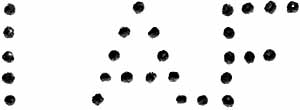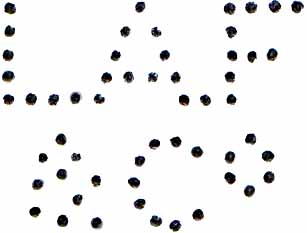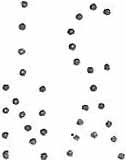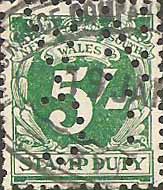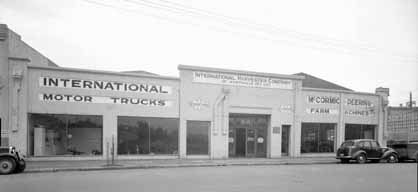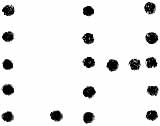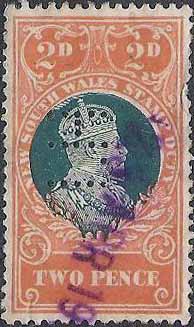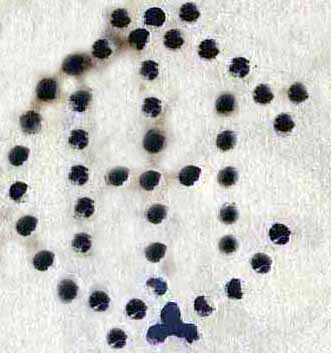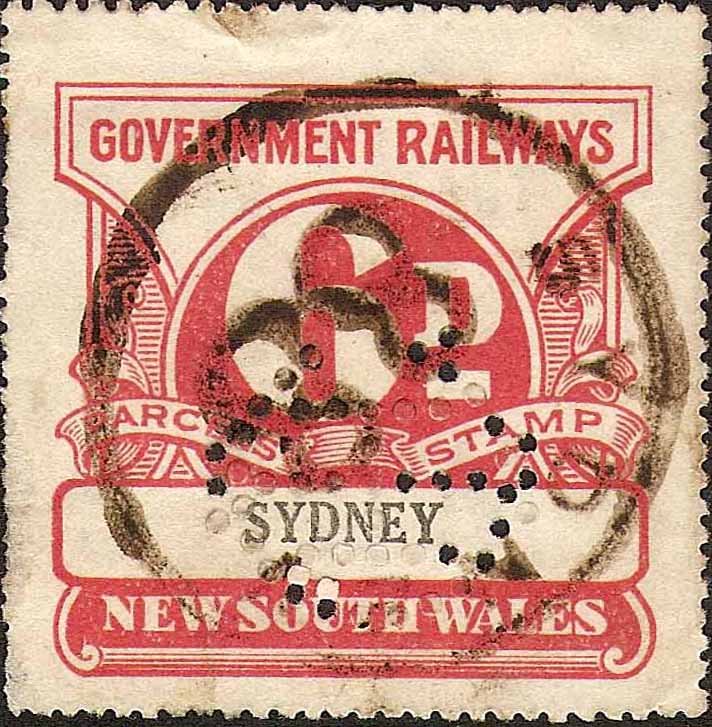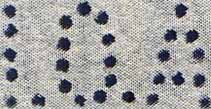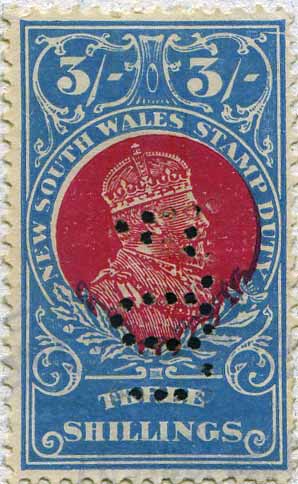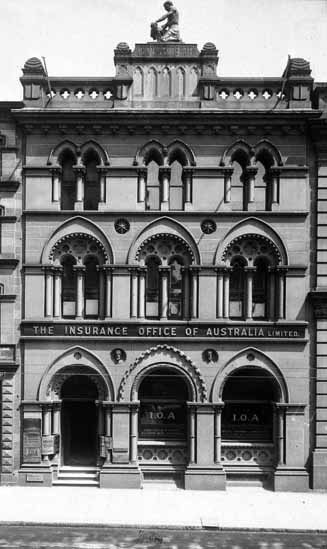|
Private Revenue Perfins of New South Wales An Elsmore Coath production The authors would welcome your comments additions or input into this work A B C D E F G H I J K L M N O P Q R S T U V W Y Other I -------------------------------------------------------- IAF Incorrect reporting
Both CPA (1992) and HAPP (2003) list the pattern IAF as being found on the revenue stamps of NSW.
These reports are incorrect as there is no IAF device used in Australia.
The confusion arises from strikes made from the LAF/&CO.a device, which started to degrade around 1920, and strikes after this time are often unclear with many blind and missing pins.
The user of the LAF/&CO.a device is not reported in either CPA or HAPP but it is known to have been used by L A Fairburn & Co in Melbourne.
The LAF/&CO.a patterns are not found on the revenue stamps of NSW. The device was located in Melbourne.
This is found on the revenue stamps of Victoria and this fact may have contributed to the miss report. -------------------------------------------------------- IC/NA.a
User: Insurance Co of North America Address: 14 Spring St, Sydney, NSW Later 22-30 Bridge St, Sydney NSW Revenue Use: Numeral 1929-66 issue 3d, 6d, 9d, 1/-, 1/6d, 2/-, 2/6, 3/-, 4/-, 5/-, 8/-[brown], 10/-, 16/-, £1, 30/-, £5, £10 Decimal 1966 4c, 5c, 6c, 8c, 50c, 80c, 90c, $1, $2, $3, $20 Rarity Scale: Numeral 1929-66 issue 3d R4, 6d R3, 9d R4, 1/- R3, 1/6d R4, 2/6 R3, 3/- R3, 4/- R4, 5/- R3, 8/-[brown] R4, 10/- R4, 16/- R4, £1 R3, 30/- R3, £5 R4, £10 Decimal 1966 4c R4, 5c R4, 6c R4, 8c R4, 50c R3, 80c R4, 90c R4, $2 R3, $3 R3, $20 R4 Background: The Insurance Company of North America (INCA) was founded in Philadelphia, USA, in 1792 and makes claim to be the oldest fire and marine insurance company in America. The companies initial focus was in the huge US insurance market but they expanded into Canada in 1873, and in 1897, it appointed the Yang-Tsze Insurance Association, Ltd., as its agents in China. The company was certainly writing insurance business in Australia as early as 1890 but this was largely limited to NSW. Towards the end of the 19th Century the company expanded from the traditional fire and marine business into growing motor insurance market as well as accident cover through the creation of the Indemnity Insurance Company of North America. After WWI the INCA joined the American Foreign Insurance Association (AFIA); which promoted the expansion of US Insurance companies into overseas markets. This saw the company create branches in Canada, Mexico, China and England as well as building a network of agents in other overseas locations including Australia and New Zealand. In the 1940’s the company was instrumental in the creation of ‘multi line policies’ that allowed different insurance risks to be written into the same policy. In 1950, INCA launched its ‘Homeowners Policy’; which combined fire, theft, and liability into a single policy. Following WWII the company continued to expand its operations in Australia and completed its capital city branch structure when it opened an office in Perth in 1954. During the 1960’s the company expanded into Life and Workers Compensation insurance and in 1982 they merged with Connecticut General to form CIGNA. In early to mid 1960 (as late as 1965) the company was acquired by the Sun Insurance Office which had itself just merged with the Alliance Assurance company to form Sun Alliance Insurance. Around this time the company moved to the Sun Alliance Builkding at 22 – 30 Bridge St, Sydney, NSW. Background: The IC/NA.a device is most likely a single die device as multiple strikes of the pattern do not show any consistent relationship to each other. The IC/NA.a pattern is only found on the revenue stamps of NSW. The IC/NA.a device came in to service in 1956 and was used until at least 1966. Early examples of the pattern show clear strikes but by the early 1960's the device degraded somewhat and this was particularly noticeable in the letters N and A which show consistent missing pins. The die is rather large and not suited to the small format Numeral and Decimal series of NSW and as a result it would have been difficult for the operator to get consistent central strikes. Accordingly the pattern is often found as a partial of one or more strikes on a single stamp. Related Patterns: Refer to other Sun Alliance and related patterns in: NSW: ACO…a S.I/O.a Other – Section 2 Commercial Overprints Alliance/Assurance Ltd.a Alliance/Assurance/Co/Ltd.a QLD: AA/CO.a SA: AA/CO.a TAS: AA/CO.a ------------------------------------------------------ IH.a
User: International Harvester Co of Australia Pty Ltd Agricultural Equipment Address: 37 Broadway, Glebe, NSW Revenue Use: Reported but unseen by the Authors. Background: *The first International brand vehicles arrived in Australia from the USA in 1908 and proved popular for both freight and passenger work. The International Harvester Company of Australia Pty. Ltd. was formed in 1912 and was located offices in Bourke Street Melbourne. State offices were later established in Brisbane, Adelaide and Sydney. The first Australian International Harvester manufacturing plant was established in Geelong, Victoria, in 1937. The first Sydney premises were located at the Broadway at Glebe. The company later moved to premises nearby at 5-11 Pyrmont Bridge Road, Camperdown, NSW. Later they moved to offices at 229-231 Castlecreagh St, Sydney, NSW.
5-11 Pyrmont Bridge Road, Camperdown, NSW
Device: International Harvester were prolific perfin users but most of their IH, IHC and IHC (logo) patterns are only found on postage stamps.
Despite the simplicity of many of the IH and IHC patterns the company seemed to go to some trouble to make each pattern different and this is generally achieved by the variation in the structure of the H and the addition, or not, of periods following each letter. This policy was also followed with IHC (logo) type patterns such as IHC.a (below).
In fact the policy seem to be a global one as discrete and discernable patterns for each location are also found with the companies IHC (logo) patterns used in North America in which each office has an additional pin in the pattern to make it identifiable to that specific location.
This IH.a pattern has not been sighted by the authors but an example has been reported on a revenue stamp of NSW. This is quite conceivable as the IH.a device although previously reported to have been located in Melbourne was in fact located in Sydney and is commonly found on the postage stamps of NSW in the period 1908 to 1910.
If any reader has an example of this pattern on a revenue stamp then we would appreciate a scan so that we can confirm its existence and show an example.
Related patterns: Refer to other International Harvester patterns in:
NSW: IH,b IHC.a
QLD: I.H..a
SA: IH.a I.H..b
VIC: IHC.a
WA: IHC.a
*International Harvester: 'Tractors and Equipment in Australia and New Zealand' By Graeme R. Quick (2009) *Trove -------------------------------------------------------- IH.b
User: International Harvester Co of Australia Pty Ltd Agricultural Equipment Address: 37 Broadway, Glebe, NSW Revenue Use: KEDVII 1909-28 issue 2d Rarity Scale: KEDVII 1909-28 issue 2d R4 Background: See IH.a above Device: As discussed in IH.a above the International Harvester Company were prolific perfin users and additionally they went to some trouble to make each of their devices, and the subsequent pattern, different from each other. The IH.b device was most likely a single die device and it came into service about 1910 and appears to have replaced the IH.a device. It is common on postage stamps of New South Wales, and later from 1913 on the postage stamps of Australia but it is very rarely found on revenue stamps and is not reported on railway stamps. Its usage spans the period from 1910 until at least 1956. Strikes on postage stamps from the late 1940’s and 1950’s often feature blind or missing pins. The device was not replaced. Related patterns: Refer to other International Harvester patterns in:
NSW: IH.a IHC.a
QLD: I.H..a
SA: IH.a I.H..b
VIC: IHC.a
WA: IHC.a -------------------------------------------------------- IHC.a Symbol
User: International Harvester Co of Australia Pty Ltd Agricultural Equipment
Address: 37 Broadway, Glebe, NSW
Later 5-11 Pyrmont Bridge Road, Camperdown, NSW
Later 229-231 Castlereagh St, Sydney, NSW Railway Use: 1929 issue 9d, 1/- Rarity Scale: 1929 issue 9d R4, 1/- R4 Background: See IH.a
In fact it is reasonable to suggest that this IHC.a (logo) device was purchased specifically for use on railway stamps as the Sydney office of the company are known to have used two IH devices (including IH.a above) over the period 1908 until 1955 and yet these patterns are not found on NSW railway stamps.
QLD: I.H..a
SA: IH.a I.H..b
VIC: IHC.a
WA: IHC.a -------------------------------------------------------- IOA.a
User: (The) Insurance Office of Australia Insurance Provider Address: 259 George St, Sydney, NSW Revenue Use: KEDVII 1909-28 issue 4d, 8d, 1/-, 2/-, 2/6, 3/-, 4/- 5/-, 10/-, £1 Numeral 1917-28 issue 2d Numeral 1929-66 issue 2d, 3d, 4d, 6d, 6d[no wmk], 8d, 9d, 1/-, 1/6, 2/-, 2/6, 2/6[orange], 3/-, 4/-, 5/-, 6/-, 10/-, 10/-[underprint], 14/-, £1 Rarity Scale: KEDVII 1909-28 issue 4d R2, 8d R2, 1/- R1, 2/- R3, 2/6 R3, 3/- R3, 4/- R3, 5/- R3, 10/- R4, £1 R3 Numeral 1917-28 issue 2d R4 Numeral 1929-66 issue 2d R3, 3d R3, 4d R2, 6d R3, 6d[no wmk] R4, 8d R2, 9d R2, 1/- R1, 1/6 R2, 2/- R2, 2/6 R2, 2/6[orange] R4, 3/- R2, 4/- R2, 5/- R3, 6/- R3, 10/- R2, 10/-[underprint] R4, 14/- R4, £1 R1 Background: *The Insurance Office of Australia was formed in Sydney in 1910 and they initially occupied premises at 263-265 George St, Sydney. The company expanded quickly establishing a London office as well as a presence in the State capitals and central Queensland as far north as Rockhampton. The company focused mainly on fire and accident policies. In 1922 the company undertook some marine underwriting through its London office and this exposed them to considerable loss. At around this time almost all of the shares in the company were acquired by the larger English insurer the ‘North British and Mercantile Insurance Company’ who had held offices in Australia since 1878. However as is often the case with such acquisitions in the Insurance industry the acquired company continued to trade under its own name. At the 1923 Annual Meeting of the company it was decided to close the London office and concentrate on the Australian market. With the backing of the North British and Mercantile Insurance Company the Insurance Office of Australia prospered and in the early 1920’s they opened a large premises at 54-56 Market St, Melbourne. The company remained profitable and continued to grow and after World War 2 they moved to even larger premises at 259 George St, Sydney, NSW which was the head office of the North British and Mercantile Insurance Company. North British and Mercantile and by consequence the Australia Insurance Office were absorbed into the merger of General Accident and Commercial Union that became CGU Insurance.
265 George St, Sydney c1920 Device: The IOA.a device is a single head device, as multiple strikes show no consistent relationship to each other. Furthermore the device is able to achieve single central strikes on stamps of a variety of formats, including small formats such as the 1929 Numeral series, as well as the larger format stamps such as the earlier Edward VII bi colours. The pattern is found on the revenue stamps of NSW but also on the postage stamps of Australia over the period 1920 until at least 1964. The device was most likely designed to suit the larger format stamps such as the KGV postage stamps and it can be found on the issues in variations of both positions 1 and 2. However when applied to smaller format stamps, such as the 1929 Numeral issues, or the KGVI definitive, the width of the die becomes a problem and on these issues the pattern is often found as a partial and often with evidence of strikes from adjoining stamps. This is less often the case when strikes are made in position 2 or similar. Related Patterns: Refer to other Insurance Office of Australia patterns in: VIC: IOA.a *Trove -------------------------------------------------------- A B C D E F G H I J K L M N O P Q R S T U V W Y Other © copyright 2011 |
